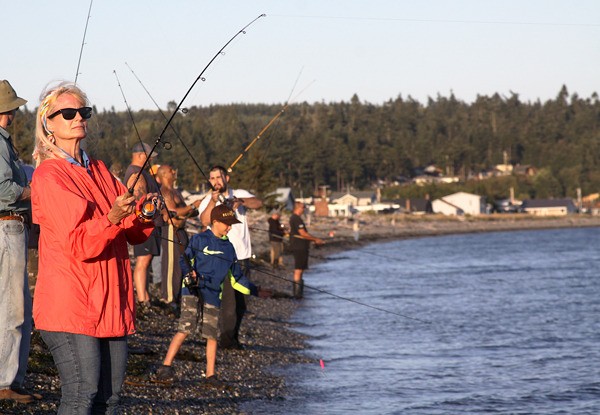It can be a badge of honor or a mark of shame.
If you’re a salmon angler worth your salt on Whidbey Island and have logged ample time on the water or shore this summer, chances are the sport catch record card that accompanies your saltwater recreational fishing license is brimming with check marks for pink salmon.
A full card represents 26 salmon caught, and a source of bragging rights for the most dedicated anglers who’ve lined the western shores of the island since the pink salmon season started in that area on July 1.
As the season enters August, traditionally the peak time to catch pinks, some anglers have already filled their first card and are starting on another.
One of those anglers is Oak Harbor’s Keith Glass, who caught his 32nd salmon of the season Thursday morning.
And here’s the kicker — Glass didn’t start fishing until July 21.
“If you can’t catch a pink, you shouldn’t be fishing,” Glass said as he stood knee-deep in water at the Keystone spit in Coupeville, jigging for pinks.
“Everyone has their own system. Imitate it and you’ll catch fish.”
Glass’ method is nonstop motion. He casts a pink Buzz Bomb about 60 feet into the water, then just as it hits the water, he’s already cranking on his spinning reel. He jerks the rod, reels one rotation, jerks the rod, reels another rotation and continues this rhythmic dance until the pink lure, trailing a pink squid, surfaces next to him.
Then he does this routine all over again, dozens of times, trying to provoke a strike from a salmon.
“It just pisses them off,” Glass said.
Jigging is the most common way shore anglers try to hook into pinks, which are also called humpies because of the humpbacks males develop during their spawning migration.
The pursuit of pinks from shore is one of Whidbey’s most popular outdoor recreational pastimes because of the accessible beaches, abundance of fish and a more generous four-fish daily limit.
The opportunity comes around every odd-numbered year when the pinks return to Puget Sound in the millions bound for their rivers of origin.
An estimated 6.8 million pinks are expected to swim through Puget Sound this summer with most passing by Whidbey and a good portion hugging the island’s exterior shores to avoid strong currents.
Of those forecasted fish, 1.6 million pinks are headed for the Snohomish River system and 600,000 are looking to swim underneath the Deception Pass bridge en route to the Skagit River.
Unless, that is, they encounter a snag.
Fishing for pinks is generally considered the best bet for a novice angler looking to experience the thrill of catching a salmon.
It can be a test of patience to wait for fish to come through in big numbers to have the best shot at hooking into one. Some anglers don’t cast in until they see fish jump or notice others starting to reel them in.
For beginners, pink salmon fishing also requires mastery of the art of copycatting to try to mimic what the most successful anglers are doing to fill their sport catch record cards.
A little knowledge of tides doesn’t hurt, either.

Anglers generally consider the best time to fish for humpies to be the hour before and the hour after high tide but fisher preferences vary.
Slack tide, the short period between tides when the water is still, is another angler favorite.
“I’m not really a tide man,” said Oak Harbor’s Glyn Hackett, who’s caught two dozen salmon this summer from the shore. “Some people swear by it. I just don’t.”
Hackett’s lure of choice is a pink Rotator, trailing a pink plastic squid, also called a skirt or hoochie.
Hackett doesn’t yank back on the line as frequently as Glass, which causes temporary slack that allows the lure to flutter downward, resembling an injured bait fish.
Some anglers don’t jig with Rotators at all, they just slowly reel them in.
Most agree that long casts increase the chances for success, so using a lighter line from 10-to-12 pound test is considered optimal for pinks, which generally weigh less than 5 pounds.
“Humpies like a slow retrieve,” said Bob Crouch, store manager at Sebo’s Hardware store in Bayview and Whidbey angler since 1973.
Crouch prefers to use Rotators and doesn’t jig.
As with either lure, only a single, barbless hook is allowed.
“Sometimes, they’ll follow your lure all the way to shore and and smack it 2 feet from shore,” Crouch said. “With those guys, you’ve got to be real careful.”
Joel Talicuran’s secret might be tucked away in his sweat-jacket pocket.
It is there that he keeps a bottle of fish oil that he squirts on to a pink Buzz Bomb and skirt that he ties directly to his line.
“It smells,” Talicuran said of the fish attractant. “It smells like herring.
“It makes a difference.”
Talicuran caught two pinks Thursday to fill up his first catch record card, forcing him to buy another.
He likes to fish at Keystone, one of the island’s most popular shore fishing areas where it’s not uncommon to see 40 anglers lining the bank.
Other popular fishing areas are Fort Casey State Park, Ebey’s Landing and the entire west beach. Favorites in the south are Bush Point and Lagoon Point.
North Whidbey’s hottest spot opens today along the north shore at Deception Pass.
The pinks have arrived early this season and the best fishing is yet to come with bigger fish in massive numbers expected to hug the banks over the next few weeks.
Anglers also are catching the more desired silver salmon, which will pick up in numbers the next two months.
Fishing for king salmon is closed.
Pinks suit Talicuran just fine as does the serene backdrop of mountains and saltwater.
“I like the sun and the air,” he said. “And the salmon make my heart beat sometimes.”


